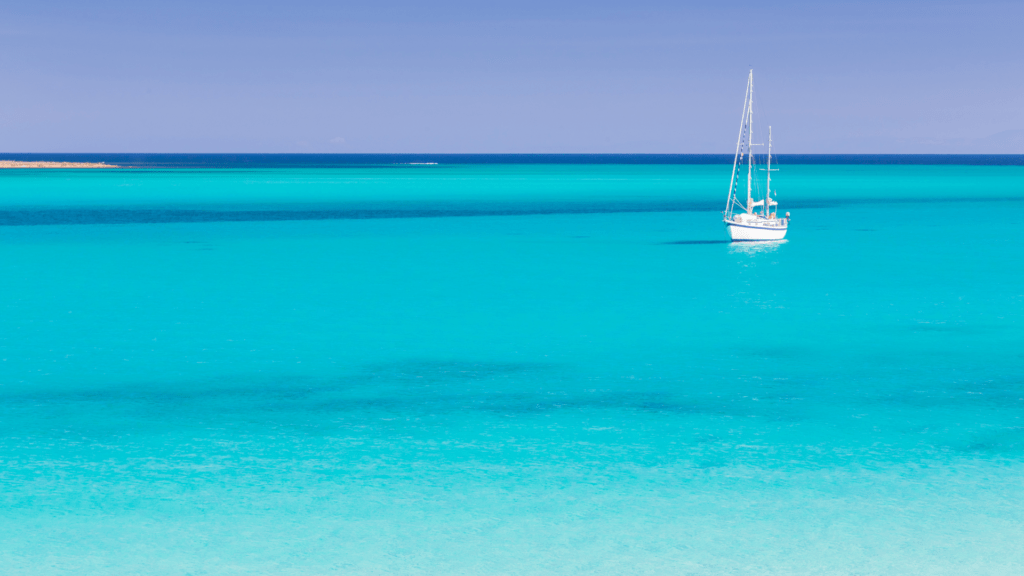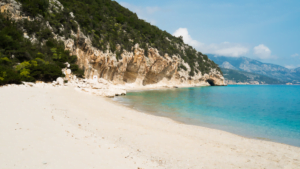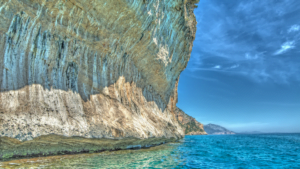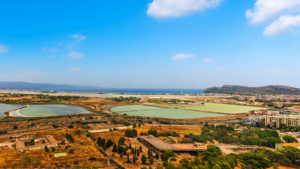Northern Sardinia, an idyllic region in the heart of the Mediterranean, is a treasure trove of natural beauty, rich history, and cultural charm. This part of the island offers a unique blend of stunning beaches, historic sites, and quaint villages, making it a perfect destination for travelers seeking both relaxation and adventure.

The coastline of Northern Sardinia is renowned for its crystal-clear waters and pristine white-sand beaches. Iconic spots like La Pelosa Beach and Cala Coticcio on Caprera Island are celebrated for their picturesque settings and tranquil ambiance. These beaches, often fringed by rugged cliffs and lush vegetation, provide an ideal backdrop for sunbathing, swimming, and snorkeling.
Northern Sardinia also boasts a wealth of historical and cultural attractions. The cities of Alghero, Sassari, and Olbia offer a glimpse into the island’s rich past, with their ancient architecture, vibrant festivals, and local traditions. Alghero, known for its Catalan heritage, charms visitors with its medieval old town and lively waterfront. Sassari, with its grand piazzas and historic buildings, and Olbia, the gateway to the luxurious Costa Smeralda, each provide unique experiences steeped in history and culture.
Beyond the cities, the region’s small villages, such as Castelsardo and Palau, exude a timeless charm. These villages are often perched on hilltops or nestled along the coast, offering stunning views and a slower pace of life. Castelsardo, with its medieval castle and narrow, winding streets, is particularly captivating, while Palau serves as a gateway to the La Maddalena Archipelago, a paradise for nature lovers and boating enthusiasts.
Top Beaches
La Pelosa Beach, Stintino


Description
La Pelosa Beach, located near the village of Stintino, is renowned for its crystal-clear turquoise waters and fine white sand. Often compared to Caribbean beaches, La Pelosa boasts shallow waters that extend far into the sea, making it ideal for families and those who enjoy wading and swimming in calm waters. The scenic beauty is complemented by views of the Torre della Pelosa, a historic tower that adds to the picturesque landscape.
Tips for Visiting
- Reservations: During peak season, it is mandatory to make reservations to visit La Pelosa Beach. This can be done online, and it helps manage the number of visitors to preserve the beach’s pristine condition.
- Best Times to Go: The best time to visit is early in the morning or later in the afternoon to avoid the midday crowds. Visiting during the shoulder seasons (May-June and September-October) can also provide a more tranquil experience.
- Amenities: There are facilities such as parking (paid), restrooms, and places to rent sun loungers and umbrellas. Be sure to bring your own food and water, as the availability of nearby restaurants and shops can be limited.
Spiaggia di Lu Impostu


Features
Spiaggia di Lu Impostu, located near San Teodoro, is known for its long stretch of white sand and shallow, clear waters that make it perfect for swimming and snorkeling. The beach forms a beautiful bay with a backdrop of lush vegetation, creating a serene and picturesque setting.
Necessary Preparations
- Booking in Advance: Similar to La Pelosa, it is necessary to book your visit in advance, especially during the summer months. This can usually be done online.
- Parking Info: Parking is available but typically requires a fee. It is advisable to arrive early to secure a spot, especially during the high season.
- Amenities: The beach offers basic amenities, including a bar service and sun lounger rentals. Ensure to check in at the entrance if you have pre-booked your visit.
Cala Coticcio, Caprera Island


Description
Cala Coticcio, also known as “Tahiti,” is located on the island of Caprera, part of the La Maddalena Archipelago. It is celebrated for its crystal-clear waters, striking rock formations, and vibrant underwater life, making it a popular spot for snorkeling and diving.
Access Details
- By Boat: The most common way to reach Cala Coticcio is by boat, with several tours available from nearby Palau or La Maddalena. This ensures a more exclusive and serene experience.
- Hiking: For the more adventurous, there is a hiking trail that leads to the beach, though it can be challenging and is best suited for experienced hikers.
- Recommendations: Visiting during the early hours of the day can help avoid the crowds. Bring all necessary supplies, as there are no facilities on the beach.
Costa Smeralda


Overview of the Region Known for Its Luxury and Beauty
Costa Smeralda, located on the northeastern coast of Sardinia, is renowned for its stunning landscapes, crystal-clear turquoise waters, and opulent lifestyle. Developed in the 1960s by Prince Karim Aga Khan, this 20-kilometer stretch of coastline has become a playground for the rich and famous, featuring luxury resorts, exclusive marinas, and designer boutiques. The region is characterized by its picturesque coves, granite rock formations, and lush Mediterranean vegetation, making it one of the most beautiful and glamorous destinations in the world.
Famous Beaches and Key Attractions


- Spiaggia del Principe: Named after Prince Aga Khan, this beach is one of the most famous in Costa Smeralda. It boasts powdery white sand and shallow, emerald-green waters, perfect for swimming and snorkeling. The beach is framed by rocky outcrops and lush vegetation, providing a secluded and pristine environment.
- Liscia Ruja: Known as the “Long Beach,” Liscia Ruja is one of the largest beaches in Costa Smeralda. It features a wide expanse of fine sand and gently sloping waters, ideal for families and sunbathers. The beach is surrounded by juniper trees and offers stunning views of the coastline.
- Porto Cervo: The heart of Costa Smeralda, Porto Cervo is a luxurious resort town known for its marina filled with superyachts, high-end boutiques, and vibrant nightlife. Key attractions include the Stella Maris Church, with its striking modern architecture, and the Promenade du Port, a chic shopping and dining area.
- Pevero Golf Club: For golf enthusiasts, the Pevero Golf Club is a must-visit. This world-class golf course, designed by Robert Trent Jones, offers 18 holes set against the backdrop of the Mediterranean Sea, with challenging terrain and breathtaking views.
High-End Shopping and Dining Experiences
Costa Smeralda is synonymous with luxury shopping and gourmet dining. The region offers an array of designer boutiques, upscale restaurants, and exclusive clubs.
- Luxury Shopping: Porto Cervo’s Promenade du Port and La Piazzetta are hubs for high-end shopping, featuring brands like Prada, Gucci, and Louis Vuitton. These areas are perfect for indulging in some retail therapy amidst stunning surroundings.
- Fine Dining: The dining scene in Costa Smeralda is as glamorous as its clientele. Michelin-starred restaurants like Ristorante Cala di Volpe offer exquisite Mediterranean cuisine with a focus on fresh, local ingredients. Other notable dining spots include Ristorante Pescatore and Il Portico, where you can enjoy gourmet dishes while overlooking the beautiful coastline.
- Nightlife: For those seeking vibrant nightlife, Costa Smeralda doesn’t disappoint. Clubs like Billionaire and Phi Beach are legendary for their exclusive parties, celebrity sightings, and electrifying atmosphere.
Tips for Budget-Conscious Travelers
While Costa Smeralda is known for its luxury, there are ways for budget-conscious travelers to enjoy the region without breaking the bank.
- Visit Off-Season: Prices for accommodation, dining, and activities drop significantly outside the peak summer months of July and August. Visiting in May, June, September, or October can provide a more affordable and less crowded experience.
- Affordable Dining: Seek out trattorias and pizzerias in nearby towns such as Arzachena or San Pantaleo, where you can enjoy delicious local cuisine at a fraction of the cost of Porto Cervo’s upscale restaurants.
- Public Beaches: While some beaches in Costa Smeralda have private sections, there are plenty of beautiful public beaches where you can relax without any fees. Spiaggia Capriccioli and Spiaggia del Pevero are excellent options.
- Accommodation: Consider staying in budget-friendly accommodations outside the main luxury hubs. Nearby towns like Cannigione and Baja Sardinia offer more affordable lodging options, including guesthouses, B&Bs, and campgrounds, while still providing easy access to Costa Smeralda’s attractions.
Exploring Costa Smeralda doesn’t have to be reserved only for the wealthy. With some savvy planning, budget-conscious travelers can also experience the beauty and allure of this iconic region.
Islands and Archipelagos
La Maddalena Archipelago


Overview
The La Maddalena Archipelago, located off the northeastern coast of Sardinia, consists of over 60 islands and islets. It is known for its stunning natural beauty, with crystal-clear waters, unspoiled beaches, and a rich variety of flora and fauna. The main island, La Maddalena, is the only inhabited one and serves as the administrative center of the national park.
Main Attractions
- La Maddalena Town: The town offers charming narrow streets, historical buildings, and a vibrant marina. It is a great starting point for exploring the archipelago.
- Giuseppe Garibaldi Memorial: Located on the island of Caprera, this museum is dedicated to the famous Italian revolutionary who spent his last years here.
Notable Beaches and Spots
- Spiaggia Rosa (Pink Beach), Budelli Island: Known for its unique pink sand, which gets its color from crushed coral and shells. Access is restricted to preserve its beauty, but it can be admired from boats.
- Cala Corsara, Spargi Island: Famous for its clear waters and dramatic rock formations. It is accessible only by boat and offers excellent snorkeling opportunities.
- Cala Coticcio, Caprera Island: Often referred to as “Tahiti” for its exotic appearance, this beach is renowned for its turquoise waters and scenic views. It can be reached by boat or a challenging hiking trail.
Asinara Island


History and Significance
Asinara Island, situated off the northwest coast of Sardinia, has a fascinating history. Once used as a quarantine station and later as a maximum-security prison, it has been preserved in a near-pristine state due to its isolation. In 1997, it was designated as a national park and subsequently a marine protected area, highlighting its ecological importance.
Activities and Tours
- Guided Tours: There are several guided tours available, including off-road vehicle tours, bike tours, and hiking excursions. These tours provide insights into the island’s history and its unique ecosystem.
- Wildlife Viewing: The island is home to a variety of wildlife, including the famous albino donkeys, wild boars, and numerous bird species. Visitors can explore the island’s diverse habitats, from coastal areas to rugged interiors.
- Marine Activities: Asinara’s marine protected area offers opportunities for snorkeling and diving. The clear waters around the island are rich in marine life, making it a great spot for underwater exploration.
Both the La Maddalena Archipelago and Asinara Island offer visitors a unique blend of natural beauty, historical intrigue, and a range of outdoor activities, making them must-visit destinations in Northern Sardinia.
Historic Towns and Cities
Alghero


Historical Significance and Catalan Influence
Alghero, located on the northwest coast of Sardinia, is known for its strong Catalan influence, a remnant of the 14th century when the town was captured by the Crown of Aragon. The Catalan presence is still evident today in the local dialect, architecture, and traditions, earning Alghero the nickname “Barceloneta” or “Little Barcelona.” The historic center features narrow cobbled streets, Gothic buildings, and Catalan-Gothic churches, reflecting its unique heritage.
Key Attractions
- Coral Riviera: Alghero is often called the “Coral Riviera” due to its high-quality red coral, which has been harvested since ancient times. The coral is used in local jewelry and can be seen in various shops and markets.
- Alghero Cathedral: This Gothic-style cathedral, dedicated to St. Mary, is a centerpiece of the old town with its impressive architecture and history.
- Local Cuisine: Alghero’s culinary scene is a delightful blend of Sardinian and Catalan flavors. Local specialties include paella algherese, lobster Catalan style, and a variety of seafood dishes, often accompanied by the region’s renowned wines.
Sassari


Important Cultural and Historical Sites
Sassari, the second-largest city in Sardinia, is rich in cultural and historical landmarks. The city’s historic center is a maze of narrow streets and grand piazzas, showcasing a mix of architectural styles.
- Piazza d’Italia: Known as the “living room” of Sassari, this large square is surrounded by important buildings such as the Palazzo della Provincia and the Neo-Gothic Palazzo Giordano.
- Cathedral of San Nicola: This cathedral, a blend of Gothic, Baroque, and Neoclassical styles, is one of Sassari’s most significant religious sites.
- Museo Nazionale Sanna: A museum featuring archaeological finds, including artifacts from the Nuragic civilization, Roman remains, and medieval art.
Local Festivals and Events
- Cavalcata Sarda: Held annually in May, this event showcases traditional Sardinian costumes, music, and dance, culminating in a colorful parade through the city.
- Faradda di li Candareri (Descent of the Candlesticks): A UNESCO-recognized event held in August, where large, decorated wooden candlesticks are carried through the streets in a lively procession, celebrating the city’s patron saint.
Olbia


Gateway to Costa Smeralda
Olbia is a bustling city and a primary gateway to the famous Costa Smeralda, known for its luxury resorts, beautiful beaches, and vibrant nightlife. The city’s strategic location makes it a crucial transport hub with a busy port and international airport.
Points of Interest
- Basilica of San Simplicio: An 11th-century Romanesque church, one of the most important religious sites in northern Sardinia.
- Archaeological Museum of Olbia: This museum offers insights into the city’s history, from prehistoric times through to the Roman period.
- The Vibrant City Center: Olbia’s city center is lively, with numerous shops, restaurants, and cafes. The Corso Umberto is the main street, bustling with activity and providing a taste of local life.
- Nuraghe Riu Mulinu: An archaeological site just outside the city, featuring the remains of a Bronze Age Nuragic complex, offering a glimpse into Sardinia’s ancient past.
Charming Villages
Castelsardo


Medieval Charm and Main Attractions
Castelsardo is a picturesque medieval village perched on a hilltop overlooking the Gulf of Asinara. Its narrow, winding streets, historic buildings, and panoramic views make it a charming destination.
- Doria Castle: The centerpiece of Castelsardo is the Doria Castle, built in the 12th century. The castle now houses the Museum of Mediterranean Weaving, which showcases traditional Sardinian crafts and textiles. The views from the castle’s ramparts are spectacular, offering vistas of the town and coastline.
- Cathedral of Sant’Antonio Abate: This cathedral, located near the castle, features beautiful interiors and a bell tower that provides stunning views of the surrounding area.
Local Crafts and Traditions
Castelsardo is renowned for its traditional crafts, especially basket weaving. The local women often weave intricate baskets from reeds and palm leaves, a craft passed down through generations. Visitors can purchase these handmade items as souvenirs and watch demonstrations of the weaving process.
Palau


Starting Point for Trips to La Maddalena
Palau is a small but vibrant coastal town, best known as the gateway to the La Maddalena Archipelago. The town’s port is bustling with activity, with ferries and boat tours departing regularly for the islands.
Notable Beaches and Restaurants
- Porto Pollo: A popular beach near Palau, known for its excellent windsurfing and kitesurfing conditions. The beach has a lively atmosphere with several bars and restaurants nearby.
- Spiaggia di Punta Nera: Another beautiful beach offering clear waters and soft sand, ideal for a relaxing day by the sea.
- Restaurants: Palau has a variety of dining options, from casual beachside eateries to more upscale restaurants. Local seafood is a highlight, and many restaurants offer fresh catches of the day.
Porto Cervo


Known for Luxury and High-End Shopping
Porto Cervo is synonymous with luxury, being the heart of the Costa Smeralda. It attracts the international jet set with its designer boutiques, upscale restaurants, and glamorous nightlife.
- Luxury Shopping: Porto Cervo is home to numerous high-end boutiques, including brands like Prada, Gucci, and Louis Vuitton. The Promenade du Port area is a popular spot for shopping, offering a mix of luxury and artisanal shops.
- Marina: The marina is filled with luxury yachts, adding to the town’s exclusive atmosphere. It’s a great place for a leisurely stroll and people-watching.
Tips for Budget-Conscious Travelers
- Visit Off-Season: Prices for accommodation and dining are significantly lower outside the peak summer months. Visiting in the spring or fall can be more affordable and less crowded.
- Dining: While Porto Cervo is known for its expensive restaurants, there are more affordable options available. Look for pizzerias or trattorias offering local cuisine at reasonable prices.
- Accommodation: Instead of staying in the heart of Porto Cervo, consider nearby towns such as Cannigione or Arzachena, which offer more budget-friendly lodging options while still being close to the attractions of Costa Smeralda.
These charming villages each offer a unique slice of Northern Sardinia’s diverse appeal, from the medieval history of Castelsardo to the luxury of Porto Cervo and the vibrant coastal life of Palau.










